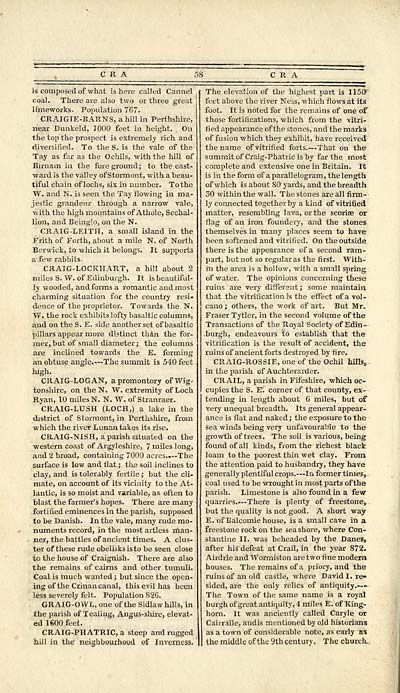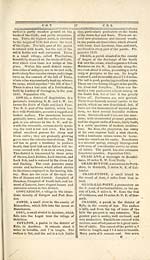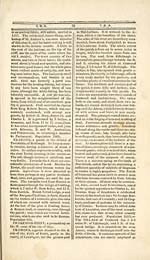Gazetteer of Scotland
(60) Page 58 - CRA
Download files
Complete book:
Individual page:
Thumbnail gallery: Grid view | List view

CRA
is composed of what is here called Caimel
coal. There are also two or three great
limeworks- Population 767.
CRAIGIE-BARNS, a hill in Perthshire,
near Dunkeld, 1000 feet in height. On
the top the prospect is extremely rich and
diversified. To the S. is the vale of the
Tay as far as the Ochils, with the hill of
Birnam in the foreground; to the east-
ward is the valley of Stormont, with a beau-
tiful chain of lochs, sis in number. To the
W. and N. is seen the Tay flowing in ma-
jestic grandeur through a narrow vale,
with the high mountains of Athole, Sechal-
lion, and Being'.o, on the N.
CRAIG-LEITH, a small island in the
Frith of Forth, about a mile N. of North
Berwick, to which it belongs. It supports
a few rabbits.
CRAIG-LOCKHART, a hill about 2
miles S. TV. of Edinburgh. It is beautiful-
ly wooded, and forms a romantic and most
charming situation for the country resi-
dence of the proprietor. Towards the N.
TV. the rock exhibits lofty basaltic columns,
and on the S. E. side another set of basaltic
pillars appear more distinct than the for-
mer, but of small diameter; the columns
are inclined towards the E. forming
an obtuse angle. — The summit is 540 feet
high.
CRAIG -LOGAN, a promontory ofWig-
tonshire, on the N. W. extremity of Loch
Ryan, 10 miles N. N. TV. of Stranraer.
CRAIG-LUSH (LOCH,) a lake in the
district of Stormont, in Perthshire, from
which the riveT Lunan takes its rise.
CRAIG-NISH, a parish situated on the
western coast of Argyleshire, 7 miles long,
and 2 broad, containing 7000 acres..— The
surface is low and flat ; tlis soil inclines to
clay, and is tolerably fertile ; but the cli-
mate, on account of its vicinity to the At-
lantic, is so moist and variable, as often to
blast the farmer's hopes. There are many
fortified eminences in the parish, supposed
to be Danish. In the vale, many rude mo-
numents record, in the most artless man-
ner, the battles of ancient times. A clus-
ter of these rude obelisks is to be seen close
to the house of Craignish. There are also
the remains of cairns and other tumuli.
Coal is touch wanted ; but since the open-
ing of the Crinan canal, this evil has been
less severely felt. Population S26.
GRAIG-OWL, one of the Sidlaw hills, in
the parish of Tealing, Angus-shire, elevat-
ed 1S00 feel.
CRAIG-PHATRIC, a steep and rugged
hill in the' neighbourhood of Inverness.
CRA
The elevation of the highest part is 115CT
feet above the river Ness, which flows at its
foot. It is noted for the remains of one of
those fortifications, which from the vitri-
fied appearance of the stones, and the marks
of fusion which they exhibit, have received
the name of vitrified forts. — That on the
summit of Craig-Phatric is by far the most
complete and extensive one in Britain. It
is in the form of a parallelogram, the length
of which is about SO yards, and the breadth
30 within the wall. The stones are all firm-
ly connected together by a kind of vitrified
matter, resembling lava, or the scoria or
flag of an iron foundery, and the stones
themselves in many places seem to have
been softened and vitrified. On the outside
there is the appearance of a second ram-
part, but not so regular as the first. With-
in the area is a hollow, with a small spring,
of water. The opinions concerning these
ruins are very different ; some maintain
that the vitrification is the effect of a vol-
cano ; others, the work of art. But Mr.
Fraser Tytler, in the second volume of the
Transactions of the Royal Society of Edin-
burgh, endeavours to establish that the
vitrification is the result of accident, the
ruins of ancient forts destroyed by fire.
CRAIG-ROSSIE, one of the Ochil hills,
in the parish of Auchterarder.
CRAIL, a parish in Fifeshire, which oc-
cupies the S. E. corner of that county, ex-
tending in length about 6 miles, but of
very unequal breadth. Its general appear-
ance is flat and naked; the exposure to the
sea winds being very unfavourable to the
growth of trees. The soil is various, being
found of all kinds, from the richest black
loam to the poorest thin wet clay. From
the attention paid to husbandry, they have
generally plentiful crops.— In former times,
coal used to be wrought in most parts of the
parish. Limestone is also found in a few
quarries.— There is plenty of freestone,
but the quality is not good, A short way
E. of Balcomie house, is a small cave in a
freestone rock on the sea shore, where Con-
stantine II. was beheaded by the Danes,
after his defeat at Crail, in the year 872.
Airdrie and Wormiston are two fine modern
houses. The remains of a priory, and the
ruins of an old castle, where David I. re-
sided, are the only relics of antiquity.-- ■>
The Town of the same name is a royal
burgh of great antiquity, 4 miles E. of King-
horn. It was anciently called Caryle or
Cahraile, andis mentioned by old historians
as a town of considerable note, as early as
the middle of the 9th century. The church,.
is composed of what is here called Caimel
coal. There are also two or three great
limeworks- Population 767.
CRAIGIE-BARNS, a hill in Perthshire,
near Dunkeld, 1000 feet in height. On
the top the prospect is extremely rich and
diversified. To the S. is the vale of the
Tay as far as the Ochils, with the hill of
Birnam in the foreground; to the east-
ward is the valley of Stormont, with a beau-
tiful chain of lochs, sis in number. To the
W. and N. is seen the Tay flowing in ma-
jestic grandeur through a narrow vale,
with the high mountains of Athole, Sechal-
lion, and Being'.o, on the N.
CRAIG-LEITH, a small island in the
Frith of Forth, about a mile N. of North
Berwick, to which it belongs. It supports
a few rabbits.
CRAIG-LOCKHART, a hill about 2
miles S. TV. of Edinburgh. It is beautiful-
ly wooded, and forms a romantic and most
charming situation for the country resi-
dence of the proprietor. Towards the N.
TV. the rock exhibits lofty basaltic columns,
and on the S. E. side another set of basaltic
pillars appear more distinct than the for-
mer, but of small diameter; the columns
are inclined towards the E. forming
an obtuse angle. — The summit is 540 feet
high.
CRAIG -LOGAN, a promontory ofWig-
tonshire, on the N. W. extremity of Loch
Ryan, 10 miles N. N. TV. of Stranraer.
CRAIG-LUSH (LOCH,) a lake in the
district of Stormont, in Perthshire, from
which the riveT Lunan takes its rise.
CRAIG-NISH, a parish situated on the
western coast of Argyleshire, 7 miles long,
and 2 broad, containing 7000 acres..— The
surface is low and flat ; tlis soil inclines to
clay, and is tolerably fertile ; but the cli-
mate, on account of its vicinity to the At-
lantic, is so moist and variable, as often to
blast the farmer's hopes. There are many
fortified eminences in the parish, supposed
to be Danish. In the vale, many rude mo-
numents record, in the most artless man-
ner, the battles of ancient times. A clus-
ter of these rude obelisks is to be seen close
to the house of Craignish. There are also
the remains of cairns and other tumuli.
Coal is touch wanted ; but since the open-
ing of the Crinan canal, this evil has been
less severely felt. Population S26.
GRAIG-OWL, one of the Sidlaw hills, in
the parish of Tealing, Angus-shire, elevat-
ed 1S00 feel.
CRAIG-PHATRIC, a steep and rugged
hill in the' neighbourhood of Inverness.
CRA
The elevation of the highest part is 115CT
feet above the river Ness, which flows at its
foot. It is noted for the remains of one of
those fortifications, which from the vitri-
fied appearance of the stones, and the marks
of fusion which they exhibit, have received
the name of vitrified forts. — That on the
summit of Craig-Phatric is by far the most
complete and extensive one in Britain. It
is in the form of a parallelogram, the length
of which is about SO yards, and the breadth
30 within the wall. The stones are all firm-
ly connected together by a kind of vitrified
matter, resembling lava, or the scoria or
flag of an iron foundery, and the stones
themselves in many places seem to have
been softened and vitrified. On the outside
there is the appearance of a second ram-
part, but not so regular as the first. With-
in the area is a hollow, with a small spring,
of water. The opinions concerning these
ruins are very different ; some maintain
that the vitrification is the effect of a vol-
cano ; others, the work of art. But Mr.
Fraser Tytler, in the second volume of the
Transactions of the Royal Society of Edin-
burgh, endeavours to establish that the
vitrification is the result of accident, the
ruins of ancient forts destroyed by fire.
CRAIG-ROSSIE, one of the Ochil hills,
in the parish of Auchterarder.
CRAIL, a parish in Fifeshire, which oc-
cupies the S. E. corner of that county, ex-
tending in length about 6 miles, but of
very unequal breadth. Its general appear-
ance is flat and naked; the exposure to the
sea winds being very unfavourable to the
growth of trees. The soil is various, being
found of all kinds, from the richest black
loam to the poorest thin wet clay. From
the attention paid to husbandry, they have
generally plentiful crops.— In former times,
coal used to be wrought in most parts of the
parish. Limestone is also found in a few
quarries.— There is plenty of freestone,
but the quality is not good, A short way
E. of Balcomie house, is a small cave in a
freestone rock on the sea shore, where Con-
stantine II. was beheaded by the Danes,
after his defeat at Crail, in the year 872.
Airdrie and Wormiston are two fine modern
houses. The remains of a priory, and the
ruins of an old castle, where David I. re-
sided, are the only relics of antiquity.-- ■>
The Town of the same name is a royal
burgh of great antiquity, 4 miles E. of King-
horn. It was anciently called Caryle or
Cahraile, andis mentioned by old historians
as a town of considerable note, as early as
the middle of the 9th century. The church,.
Set display mode to: Large image | Transcription
Images and transcriptions on this page, including medium image downloads, may be used under the Creative Commons Attribution 4.0 International Licence unless otherwise stated. ![]()
| Gazetteers of Scotland, 1803-1901 > Gazetteer of Scotland > (60) Page 58 - CRA |
|---|
| Permanent URL | https://digital.nls.uk/97422414 |
|---|

